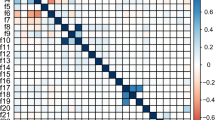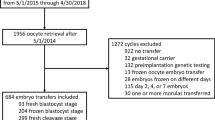Abstract
The incidence of multiple pregnancies has increased worldwide due to the use of assisted reproductive technologies, such as in vitro fertilization. In the USA, the rate of twin births has increased by nearly 80% since 1980, while the rate of triplet and higher-order births has increased by more than 400%. The overall rate of multiple births is around 3–4% of all pregnancies. Perinatal outcomes in multiple pregnancies depend on a variety of factors, including the number of fetuses, gestational age at delivery, and the health of the mother and babies. In recent decades, the multiple pregnancy rates and multiple live-birth rates have increased. Twin and multiple pregnancies are related to the increased risk of perinatal, morbidity, and mortality. The hospital-based perinatal mortality surveillance system has considered as research object in Zhejiang Province, including all the hospitals in 30 monitoring counties (districts), to collect the data for analyses. In our present study, all births (≥ 28 weeks of gestation) those born in the monitoring hospitals between 2008 and 2019 are included in the dataset. The historical data have been analyzed from 2008 to 2019 where the twin birth rate has been increased to 60.4%, while the triplet/ + birth rate has been decreased to 33.3%. In comparison with single births (7.5‰), the perinatal mortality rate within the 12 years has been increased remarkably higher in multiple births (22.0‰). In this article, on the basis of historical data, the machine learning-based forecasting models are devised, namely linear regression and SVM (support vector machine). The models show good accuracy in forecasting whether the pregnancy is singleton, multiple (normal), or multiple (abnormal). Machine learning methods cannot replace a medical practitioner but can offer a prediction model which can forecast the abnormalities in multiple pregnancies quickly for alerting a patient to get timely treatment. The accurate prediction models can save the lives of pregnant women by forecasting the abnormalities in the multiple pregnancies on time.



Similar content being viewed by others
Data availability
The datasets generated and/or analyzed during the current study are not publicly available due [ethics and privacy].
References
Akter S, Nigger N, Sarmin S (2022) Effects of multiple pregnancies on mother and foetus. KYAMC J 12(4):196–199
Antonakopoulos N, Pateisky P, Liu B, Kalafat E, Thilaganathan B, Khalil A (2020) Selective fetal growth restriction in dichorionic twin pregnancies: diagnosis, natural history, and perinatal outcome. J Clin Med 9(5):1404
Bangal VB, Patel SM, Khairnar DN (2012) Study of maternal and fetal outcome in twin gestation at tertiary care teaching hospital. Int J Biomed Adv Res 3(10):758–762
Blickstein I, Shinwell ES (2011) Obstetric management of multiple gestation and birth, Fanaroff Martin’s Neonatal-Perinatal Med. Dis. Fetus Infant. 9th ed. Philadelphia, Pa Saunders/Elsevier
Chen P, Hu KL, Jin J et al (2022) Risk factors for twin pregnancy in women undergoing double cleavage embryo transfer. BMC Pregnancy Childbirth 22:264
Esteves-Pereira AP et al (2021) Twin pregnancy and perinatal outcomes: data from ‘Birth in Brazil Study.’ PLoS One 16(1):e0245152
Giorgione V, Bhide A, Bhate R, Reed K, Khalil A (2020) Are twin pregnancies complicated by weight discordance or fetal growth restriction at higher risk of preeclampsia? J Clin Med 9(10):3276
Giorgione V, Briffa C, Di Fabrizio C, Bhate R, Khalil A (2021) Perinatal outcomes of small for gestational age in twin pregnancies: twin vs. singleton charts. J Clin Med 10(4):643
Gui Q, Yang Y, Wang L et al (2022) A nomogram to predict preterm birth in twin pregnancies. Am J Transl Res 14(10):7119–7127
Ivanov R, Yordanov S, Dinev D (2022) Internet of Things–based pregnancy tracking and monitoring service, In: 2022 international conference on automatics and informatics (ICAI), pp 298–302, https://doi.org/10.1109/ICAI55857.2022.9960012
Kaur M (2023) AI- and IoT-based energy saving mechanism by minimizing hop delay in multi-hop and advanced optical system based optical channels. Opt Quant Electron 55:635
Kim SH, Jung E, Lee MY et al (2016) The impact of introduction of fetoscopic laser surgery on twin-to-twin transfusion syndrome. Neonatal Med 23:203–210
Krispin E, Zlatkin R, Weisz B et al (2022) Labor induction in twin pregnancies: does the perinatal outcome differ according to chorionicity? Arch Gynecol Obstet 306(1):93–100
Lee S, Lee H-M, Han YJ, Kim MY, Boo HY, Chung JH (2021) Clinical utility of increased nuchal translucency at 11–13 weeks of gestation in twin pregnancies based on the chorionicity. J Clin Med 10(3):433
Parazzini F, Villa A, Moroni S, Tozzi L, Restelli S (1994) The epidemiology of multiple pregnancies. Acta Genet Medicae Gemellol Twin Res 43(1–2):17–23
Park M, Jung YW, Park J et al (2022) Successful delayed delivery of the second twin by evacuating the cord prolapsed first fetus and emergent cerclage: a report of 2 cases. BMC Pregnancy Childbirth 22:113
Qazi G (2011) Obstetric and perinatal outcome of multiple pregnancy. J Coll Physicians Surg Pak 21(3):142–145
Santana DS et al (2016) Twin pregnancy and severe maternal outcomes: the World Health Organization multicountry survey on maternal and newborn health. Obstet Gynecol 127(4):631–641
Santana DS, Surita FG, Cecatti JG (2018a) Multiple pregnancy: epidemiology and association with maternal and perinatal morbidity. Rev Bras Ginecol e Obs 40:554–562
Santana DS et al (2018b) Perinatal outcomes in twin pregnancies complicated by maternal morbidity: evidence from the WHO multicountry survey on maternal and newborn health. BMC Pregnancy Childbirth 18:1–11
Springer S et al (2020) Notching and pulsatility index of the uterine arteries and preeclampsia in twin pregnancies. J Clin Med 9(8):2653
Torres X et al (2020) Uncomplicated monochorionic twins: two normal hearts sharing one placenta. J Clin Med 9(11):3602
Vogel JP et al (2013) Maternal and perinatal outcomes of twin pregnancy in 23 low-and middle-income countries. PLoS One 8(8):e70549
Wang T, Zhang F, Gu H, H., et al (2023) A research study on new energy brand users based on principal component analysis (PCA) and fusion target planning model for sustainable environment of smart cities. Sustain Energy Technol Assess 57:103262
Werder E, Mendola P, Männistö T et al (2013) Effect of maternal chronic disease on obstetric complications in twin pregnancies in a United States cohort. Fertil Steril 100(1):142–149
Yadav N, Alwani M, Singh A (2018) Incidence and perinatal outcome of multiple pregnancy in a tertiary care centre in Central India. Int J Reprod Contraception Obstet Gynecol 7(5):1912–1918
Acknowledgements
The authors thank the staff of maternal and child healthcare institutions and monitoring hospitals for their hard work in Zhejiang Province.
Funding
This work was supported by the National Science Foundation of China (No. 71804162), the Health Science and Technology program from Health Commission of Zhejiang Province (grant number 2019RC146), Soft Science Research Program from Zhejiang Provincial Department of Science and Technology (grant number 2022C35042) and the National Education Information Technology Research (186140084).
Author information
Authors and Affiliations
Contributions
LQ performed the project development, data collection and was a major contributor in writing the manuscript. WW analyzed the data. JJ and YW edited the manuscript text. All authors read and approved the final manuscript.
Corresponding authors
Ethics declarations
Conflict of interest
The authors declare that they have no competing interests.
Ethical approval
This study was approved by the Medical Ethics Committee of Women’s hospital school of medicine Zhejiang University. All methods were performed in accordance with the relevant guidelines and regulations. Signed informed consent was obtained from all participants.
Additional information
Publisher's Note
Springer Nature remains neutral with regard to jurisdictional claims in published maps and institutional affiliations.
Rights and permissions
Springer Nature or its licensor (e.g. a society or other partner) holds exclusive rights to this article under a publishing agreement with the author(s) or other rightsholder(s); author self-archiving of the accepted manuscript version of this article is solely governed by the terms of such publishing agreement and applicable law.
About this article
Cite this article
Qian, L., Wu, W., Jiang, J. et al. The epidemiology of multiple pregnancy and perinatal outcome with the aid of machine learning-based forecasting models. Soft Comput (2023). https://doi.org/10.1007/s00500-023-08745-1
Accepted:
Published:
DOI: https://doi.org/10.1007/s00500-023-08745-1




